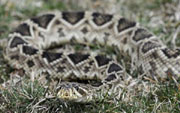VOA慢速英语2011--Progress in Fighting Snakebite Deaths(在线收听)
Health Report - Progress in Fighting Snakebite Deaths
健康报道 - 治疗毒蛇咬伤取得新进展
This is the VOA Special English Health Report.
这里是美国之音慢速英语健康报道。
Researchers are finding new ways to save snakebite victims. Experts discussed the latest findings during a recent meeting of the American Society of Tropical Medicine and Hygiene.
研究人员正在寻找拯救毒蛇咬伤受害者的新办法。在美国热带医学和卫生学会最近一次会议期间,专家们讨论了最新的研究成果。
Scientists in Australia have shown that a chemical called nitric oxide could increase the chances of surviving a poisonous snakebite. The scientists injected rats with deadly amounts of snake venom. Then they rubbed an ointment containing nitric oxide on the skin around the injection site.
澳大利亚科学家发现,一种名为一氧化氮的化学物质可能会增加被毒蛇咬伤后幸存的机会。科学家给老鼠注射了致命剂量的蛇毒,然后在注射部位周围皮肤上涂抹了一种含有一氧化氮的药膏。
The study found that the rats lived about one-third longer than if the ointment had not been used. But the treatment had to be started very quickly.
该研究发现,这些老鼠存活的时间比未使用药膏的老鼠长1/3,但必须迅速进行这种治疗。
Dirk van Helden led the research at the University of Newcastle in New South Wales. He says the nitric oxide ointment also showed promise in humans. Volunteers were injected with a harmless liquid that contained molecules about the same size as snake venom molecules.
新南威尔士州纽卡斯尔大学的德克·范赫登(Dirk van Helden)领导了这一研究。他说,这种一氧化氮药膏对人类也有效。志愿者被注射了一种无害液体,其分子大小与蛇毒分子一致。
Many snake venoms contain large molecules that can only enter the bloodstream through the body's lymphatic system. The nitric oxide slows the pumping action of the lymphatic system, and that slows the flow of venom into the blood.
许多蛇毒中含有只能通过人体淋巴系统进入血液的大分子。一氧化氮可以减缓淋巴系统的抽吸动作,从而减慢蛇毒进入血液的流动过程。
 |
| An eastern diamondback rattlesnake at the home of Chuck Hurd, a Virginia man who collects poisonous snakes |
The study appeared earlier this year in the journal Nature Medicine. Scientists say the findings could help save many lives. A study from two thousand eight found that poisonous snakes cause as many as ninety-four thousand deaths worldwide each year. But Ulrich Kuch of the Biodiversity and Climate Research Center in Frankfurt, Germany, says that estimate appears to be low.
这项研究发表在今年早些时候的《自然医学》杂志上。科学家说,这一发现有助于挽救许多生命。2008年开始的一项研究发现每年全世界有多达9.4万人因毒蛇死亡。但德国法兰克福生活多样性和气候研究中心的Ulrich Kuch表示,这一估计数字似乎有些偏低。
ULRICH KUCH: "New numbers from very rigorously designed and well-conducted studies in India and Bangladesh have come up with numbers that suggest that the real death toll of snakebites at the global level is much higher."
ULRICH KUCH:“出自印度和孟加拉国严格设计和方法得当的研究的新数字表明,全球层面上毒蛇咬伤的实际死亡人数要高得多。”
Mr. Kuch says many deaths could be prevented, but snakebite victims often go to traditional healers or do not seek any help at all.
Kuch先生说,很多死亡是可以避免的,但毒蛇咬伤受害者经常寻求传统疗法,甚至不寻求任何帮助。
ULRICH KUCH: "Either because there is no treatment available -- no antivenom, which is the specific drug to treat snakebites -- or because health care staff do not know how to treat snakebites, or because transportation to get to a health facility is not available or too expensive."
ULRICH KUCH:“要么是因为没有治疗条件--没有抗蛇毒血清,这是治疗蛇伤的特效药;要么是医护人员不知道如何治疗蛇伤;要么是因为去往医疗机构的交通不便或过于昂贵。”
There is no single antivenom that can be used to treat all snakebites. The antivenom must be specific to the kind of snake that bit the person. In some countries the treatment is costly, while in others there are problems with availability.
当前没有可以用于治疗所有蛇毒的单一抗蛇毒血清。抗蛇毒血清必须针对咬人的蛇的种类。在一些国家治疗非常昂贵,而在另一些国家获得抗蛇毒血清又存在问题。
ULRICH KUCH: "For example, antivenoms in India, they are really not expensive. But you do have an issue of distribution and of training people in treating snakebites. In other countries, such as Laos, for example, and many other Asian and African countries, there's no antivenom at all."
ULRICH KUCH:“例如,印度的抗蛇毒血清真的不贵。但在分配及培训人们治疗蛇伤上存在问题。在其它国家,如老挝和很多其它亚非国家,根本就没有抗蛇毒血清。”
Using the correct antivenom is very important. New tests are being developed to help rural health workers know the right one to give.
使用正确的抗蛇毒血清非常重要。当前正在开发新的检测方法以帮助农村医务人员确定使用哪种血清。
And that's the VOA Special English Health Report. I'm Christopher Cruise.